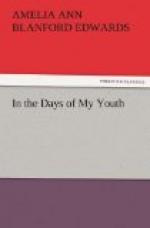And, taking up his big sword again, he retreated to his former post over against the picture. We all saw that he was resolved to say no more.
Flandrin, delighted with Mueller’s sketch, put it, with many thanks and praises, carefully away in one of the great folios against the wall.
“You have no idea, mon cher Mueller,” he said, “of what value it is to me. I was in despair about the thing till I saw that fellow this morning in the Cafe; and he looked as if he had stepped out of the Middle Ages on purpose for me. It is quite a mediaeval face—if you know what I mean by a mediaeval face.”
“I think I do,” said Mueller. “You mean that there was a moyen-age type, as there was a classical type, and as there is a modern type.”
“Just so; and therein lies the main difficulty that we historical painters have to encounter. When we cannot find portraits of our characters, we are driven to invent faces for them—and who can invent what he never sees? Invention must be based on some kind of experience; and to study old portraits is not enough for our purpose, except we frankly make use of them as portraits. We cannot generalize upon them, so as to resuscitate a vanished type.”
“But then has it really vanished?” said Mueller. “And how can we know for certain that the mediaeval type did actually differ from the type we see before us every day?”
“By simple and direct proof—by studying the epochs of portrait painting. Take Holbein’s heads, for instance. Were not the people of his time grimmer, harder-visaged, altogether more unbeautiful than the people of ours? Take Petitot’s and Sir Peter Lely’s. Can you doubt that the characteristics of their period were entirely different? Do you suppose that either race would look as we look, if resuscitated and clothed in the fashion of to-day?”
“I am not at all sure that we should observe any difference,” said Mueller, doubtfully.
“And I feel sure we should observe the greatest,” replied Flandrin, striding up and down the studio, and speaking with great animation. “I believe, as regards the men and women of Holbein’s time, that their faces were more lined than ours; their eyes, as a rule, smaller—their mouths wider—their eyebrows more scanty—their ears larger—their figures more ungainly. And in like manner, I believe the men and women of the seventeenth century to have been more fleshy than either Holbein’s people or ourselves; to have had rounder cheeks, eyes more prominent and heavy-lidded, shorter noses, more prominent chins, and lips of a fuller and more voluptuous mould.”




